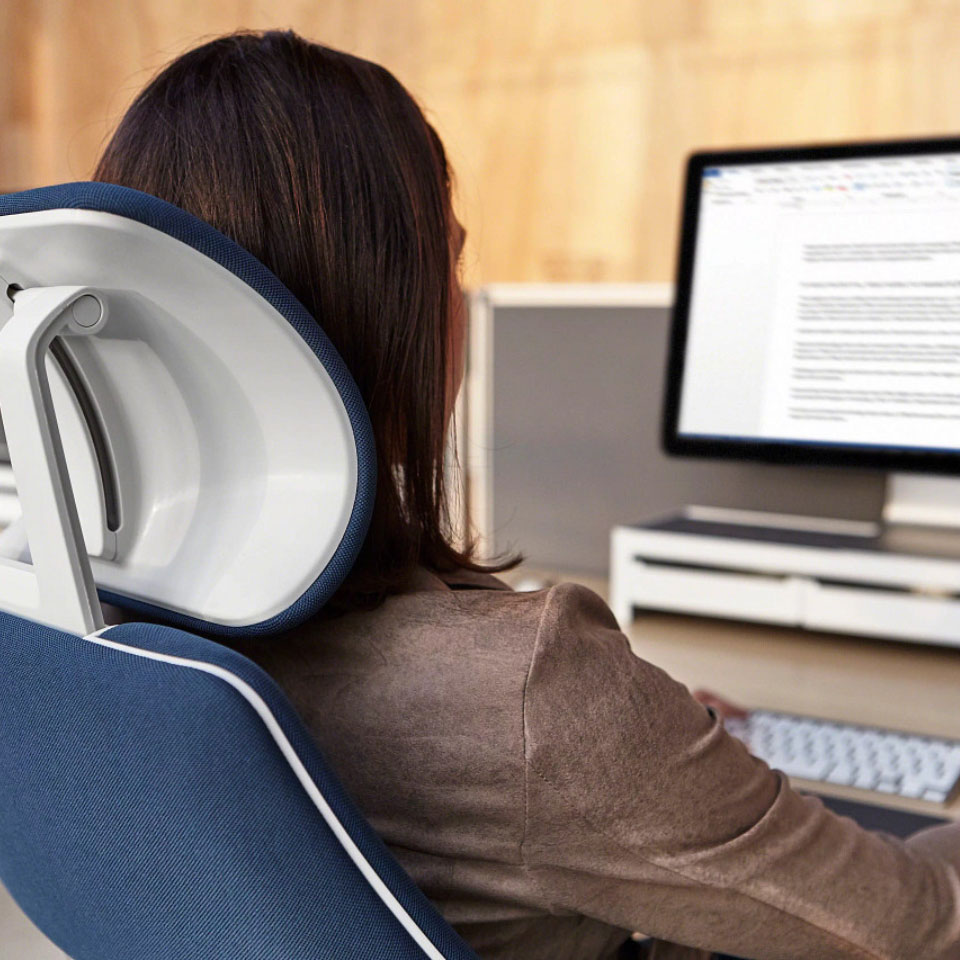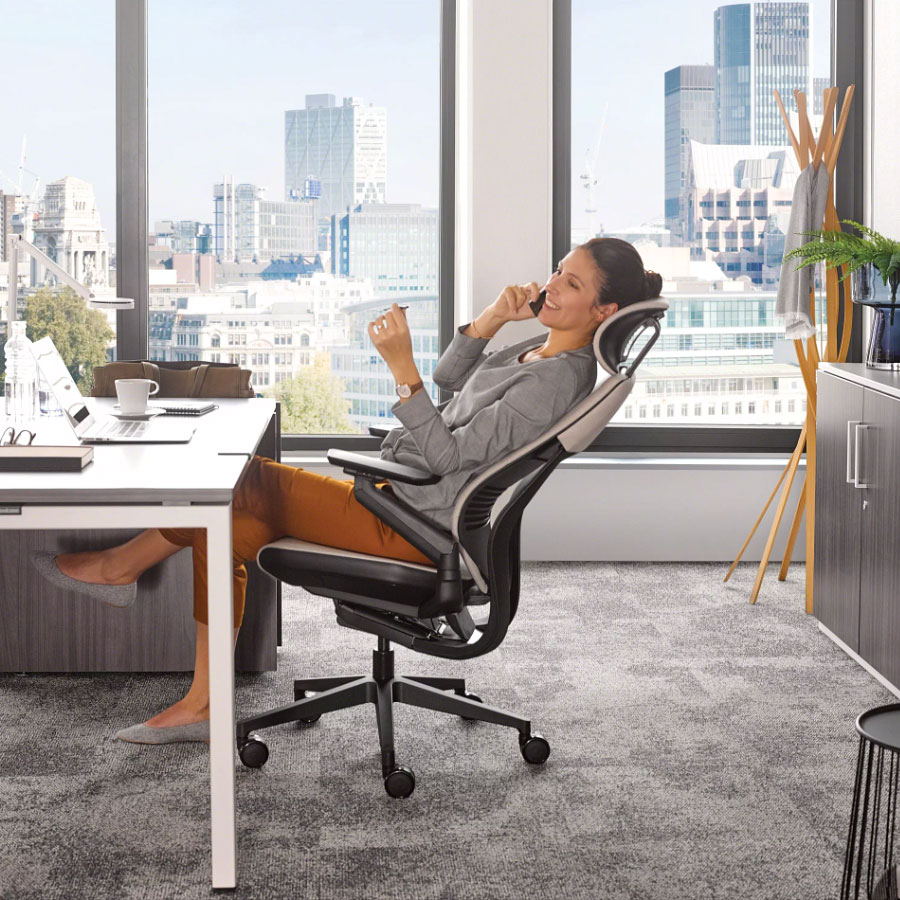Traditional office design was all about prioritising convention over real human function. These days, the tables have turned—quite literally—and workspace design has become a whole lot more user-focused than ever before.
Things like ergonomic office furniture and human-centric space planning not only make for a more productive and efficient workforce, they also deliver various physical and mental health benefits.
Humans are spending more time than ever working, which is why physical and mental wellness is such a crucial part of workspace design.
In this blog post, we define ergonomic office design and share guidance on the benefits of incorporating function-focused, human-centric furniture and spatial elements.
What is ergonomic interior design?
In a nutshell, ergonomic design is the process of adapting a space to meet human requirements.
You may have also heard it referred to as biotechnology, human engineering, biomechanics or anthropometry. All fancy words to describe the study of how the human body functions in order to design spaces, furniture and devices to support it.
In the context of the workplace, this means things like reducing fatigue and discomfort to improve operability and productivity. Or controlling acoustics to alleviate triggers of neurodiversity.
The history of ergonomic office design
While an increased emphasis on this has emerged within the industry over the past decade, it certainly isn’t a new concept.
In terms of ergonomic furniture design, it could be argued that it was Charles Darwin who subconsciously invented the very first instance of this.
Darwin cunningly attached a set of wheels to his chair in order to move around his study more quickly and unknowingly inspired the development of the furniture on castor wheels we all take for granted today.
Fast forward to the 1970s when office furniture was really put into focus. Then, meet us in 2018 when leading manufacturers like Herman Miller famously started putting ergonomics at the centre of their design processes.
Today, we see even further evolved examples of Darwin’s innovation in products like Steelcase’s Flex range.
The Steelcase Flex collection of modern office furniture features modular tables, chairs, space dividers and storage units on wheels, designed to be easily moved and reconfigured according to specific user requirements.
As we already touched on though, office ergonomics goes way beyond putting wheels on furniture. So, now, let’s take a look at how human-centric design can nurture and boost the health of employees in a host of different ways.
How can ergonomic design improve health in the workplace?
According to data shared by the Health & Safety Executive (HSE), there were 507,000 cases of musculoskeletal disorders reported in 2016/2017 with 159,000 of these being new cases.
The numbers also revealed that 31 million working days were lost during 2016/2017 and almost 9 million of these were directly related to musculoskeletal problems.
More recent data on the same topic from HSE shows that in 2022, 477,000 workers suffered from work-related musculoskeletal disorders, resulting in 7.3 million lost working days.
Although the numbers have improved, they are still high, which shows there’s still a great deal of work to be done in supporting physical health through ergonomic office design.
Let’s take a look at a few of the most prominent health problems and how an ergonomic workspace can help improve them.
Neck and back pain due to bad posture
Misalignment of the spine doesn’t only run the risk of severe neck pain and back problems, it can also impact the function of internal organs, including the digestive system.
We adopt so many postures during the working day that the future we use needs to adapt to them in order to protect the neck and spine.
Following their well-cited Global Posture Survey which discovered more than 9 new postures, Steelcase created the popular Gesture chair which is the first chair designed to support human interaction with a variety of technology.
Its Core, Limb and Seat Interfaces mean the chair mimics the movement of the human body to provide support when using a plethora of devices.
Opt for furniture like this that has been specifically designed to support the neck and spine in a range of different positions.
Read more: Combatting ‘tech neck’ through ergonomic office design >>
Decreased blood flow
Sitting for long periods of time can cut off circulation to the legs and decrease blood flow around the entire body which impacts both physical health and brain function.
Sit and Stand desks (AKA height-adjustable desks) are a great way to encourage more movement throughout the day and will help keep blood and oxygen pumping around the body.
Encouraging standing or walking meetings is also an effective way to get employees moving more throughout the day.
Allow staff to stand during meetings or leave the office to take a meeting on the move—effective collaboration doesn’t have to be static. Touchdown spaces are a great way to show staff that there are more meeting modes than the traditional gathering around a boardroom table.
Musculoskeletal disorders
This encompasses issues with joints, soft tissue, ligament, and muscle pain and is often a result of repetitive strain injury.
This is something Italian physician, Bernardino Ramazzini was already touching on in his 1717 book, Disease of Workers.
A combination of ergonomic office solutions is what is needed to combat this in order to make repetitive tasks safer and more comfortable.
For example, in the office, using wrist supports on mouse mats will reduce incidences of carpal tunnel syndrome which, according to the manufacturers of Handshoe Mouse, affects one in six office workers.
Providing a range of furniture at different heights will help employees choose more diverse postures throughout the day to reduce repetitive strain (i.e. sitting and moving in the same way for prolonged periods of time).
Cardiovascular diseases and heart problems
No matter how dynamic the workspace is, office jobs often lead to very sedentary lifestyles. This persistent idleness can result in things like cardiovascular diseases, respiratory problems and diabetes.
Again, Sit and Stand desks and walking meetings are the perfect way to encourage more movement. Including an office gym and/or yoga studio is another effective way to provide staff with opportunities to move their bodies more during the working day.
If staff are on the phone a lot (e.g. customer service roles), wireless headsets are a great way to get them up and out of their desks.
Read more: How employers can promote less sedentary lifestyles >>
Headaches and eye strain
Headaches and problems with vision are issues that have long been synonymous with office jobs but there are a whole host of ergonomic designs now available that help to reduce the effects.
Introduce desktop products that enable users to set multiple monitors at optimal distances and heights to improve posture and also limit eye strain and subsequent headaches.
Allowing employees to personalise their workspaces in this way is the most effective way to foster a happy, healthy workforce.
If you’re planning a workspace transformation project and want to incorporate more ergonomic office design elements, get in touch with our space-planning experts for advice.













